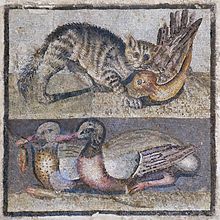
Back Opus vermiculatum Catalan Opus vermiculatum German Opus vermiculatum Spanish Opus vermiculatum French Opus vermiculatum ID Opus vermiculatum Italian Opus vermiculatum Dutch Опус вермикулатум Serbian

Opus vermiculatum is a method of laying mosaic tesserae to emphasise an outline around a subject. This can be of one or more rows and may also provide background contrast, e.g. as a shadow, sometimes with opus tessellatum. The outline created is often light and offset by a dark background for greater contrast. The name opus vermiculatum literally means "worm-like work", and has been described as one of the most demanding and elaborate forms of mosaic work.[1] Usually opus vermiculatum is meant to put emphasis on the main design and foreground details of a work, using a smooth and flowing halo-effect. Sometimes it was used only around the head of a figure. The tesserae used were often square but can be variously shaped.[2]
- ^ Berman, Alan (2000). Floors. frances lincoln ltd. ISBN 0-7112-1612-6. p. 72.
- ^ Strong, Donald (June 1, 1992). Roman Art: The Yale University Press Pelican History of Art. Yale University Press. ISBN 0-300-05293-6. p. 56